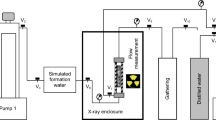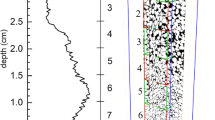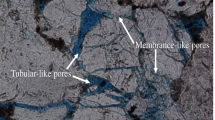Abstract
This paper is a study of determination of representative elementary volume (REV) size suitable for pore-scale flow simulation (PFS) and evaluation of permeability anisotropy for sand based on Kozeny–Carman (KC) equation. We extracted small digitized samples for PFS from the 3D structures of Toyoura sand and glass beads obtained by X-ray computed tomography. Using the digitized samples with various sizes, we performed a series of flow simulations. We characterized the sample size using the ratio of the porous length L to the median grain diameter \(D_{50}\). The \(L/D_{50}\) of REV was determined on the basis of statistical evaluation on coefficients of variations of the simulated values of void ratio, specific surface, hydraulic conductivity and hydraulic tortuosity. We confirmed that the hydraulic properties obtained from the PFS using the REV size determined agreed well with the past experimental studies. We also conducted PFSs in the horizontal direction to evaluate the permeability anisotropy. We clarified that the shape factor in the KC equation has a strong influence on permeability anisotropy even though previous studies treated hydraulic tortuosity as the only factor that affects the permeability anisotropy.









Similar content being viewed by others
Abbreviations
- k :
-
Hydraulic conductivity
- \(D_{50}\) :
-
Mean grain diameter
- e :
-
Void ratio
- \(e_{\mathrm {m}}\) :
-
Measured void ratio
- U :
-
Inlet constant seepage velocity
- i :
-
Hydraulic gradient
- \({\varDelta }_{\mathrm {p}}\) :
-
Pressure drop
- \(\rho \) :
-
Water density
- g :
-
Gravitational acceleration (9.81 m/s)
- L :
-
Sample size
- CV:
-
Coefficient of variation
- \(A_{\mathrm {STL}}\) :
-
Surface area of STL file
- \(A_{\mathrm {eff}}\) :
-
Effective surface area
- \(\mu \) :
-
Water dynamic viscosity
- \(\phi \) :
-
Shape factor
- \(\tau _{\mathrm {h}}\) :
-
Hydraulic tortuosity
- \(S_{\mathrm {S}}\) :
-
Specific surface
- \(\psi \) :
-
Particle sphericity
- \(\psi _{\mathrm {k}}\) :
-
Krumbein’s particle sphericity
- 〈u〉:
-
Volume average of the magnitude of flow velocity
- 〈ud〉:
-
Volume average of the velocity component along the flow direction
- \(\tau _{\mathrm {e}}\) :
-
Electric-tortuosity
- \(\lambda \) :
-
Confidence factor
- E :
-
Allowable error
- \(N_{\mathrm {run}}\) :
-
Required number of PFSs
- \(r_{k}\) :
-
Hydraulic anisotropy
- \(\phi _{\mathrm {V}}\) :
-
Shape factor for flow along vertical direction
- \(\phi _{\mathrm {H}}\) :
-
Shape factor for flow along horizontal direction
- \(\tau _{\mathrm {hV}}\) :
-
Hydraulic tortuosity for flow along vertical direction
- \(\tau _{\mathrm {hH}}\) :
-
Hydraulic tortuosity for flow along horizontal direction
References
Bultreys T, Boever WD, Cnudde V (2016) Imaging and image-based fluid transport modeling at the pore scale in geological materials: a practical introduction to the current state-of-the-art. Earth-Sci Rev 155:93–128. https://doi.org/10.1016/j.earscirev.2016.02.001
Carman PC (1937) Fluid flow through granular beds. Trans Inst Chem Eng 15:150–166
Costanza-Robinson MS, Estabrook BD, Fouhey DF (2011) Representative elementary volume estimation for porosity, moisture saturation, and air-water interfacial areas in unsaturated porous media: data quality implications. Water Resour Res. https://doi.org/10.1029/2010WR009655
Daigle H, Dugan B (2011) Permeability anisotropy and fabric development: a mechanistic explanation. Water Resour Res. https://doi.org/10.1029/2011WR011110
Doube M, Kłsowski MM, Arganda-Carreras I, Cordeliéres FP, Dougherty RP, Jackson JS, Schmid B, Hutchinson JR, Shefelbine SJ (2010) Bonej: free and extensible bone image analysis in imagej. Bone 47(6):1076–1079. https://doi.org/10.1016/j.bone.2010.08.023
Duda A, Koza Z, Matyka M (2011) Hydraulic tortuosity in arbitrary porous media flow. Phys Rev E 84(3):36,319
Ghanbarian B, Hunt AG, Ewing RP, Sahimi M (2013) Tortuosity in porous media: a critical review. Soil Sci Soc Am J 77(5):1461–1477. https://doi.org/10.2136/sssaj2012.0435
Hardin BO (1985) Crushing of soil particles. J Geotech Eng 111(10):1177–1192. https://doi.org/10.1061/(ASCE)0733-9410(1985)111:10(1177)
Hasegawa J, Fujinawa K, Ezawa S, Toyoda T, Watanabe T (2011) The influence of soil water hysteresis on a saturated–unsaturated flow. J Groundw Hydrol 53(1):25–39. https://doi.org/10.5917/jagh.53.25
Hasegawa S, Maeda T, Sasaki S (1977) Studies on horizontal infiltration and unsaturated hydraulic conductivity of soil. Mem Res Fac Agric Hokkaido Univ 10(3):183–205
Ishihara K (1993) Liquefaction and flow failure during earthquakes. Géotechnique 43(3):351–451. https://doi.org/10.1680/geot.1993.43.3.351
Ishikawa K, Yasuda S (2012) Liquefaction assessment of thin sand layers with partially drained condition. In: Proceedings of the 15th world conference on earthquake engineering. https://www.iitk.ac.in/nicee/wcee/article/WCEE2012_1651.pdf
Jin S, Nagao J, Takeya S, Jin Y, Hayashi J, Kamata Y, Ebinuma T, Narita H (2006) Structural investigation of methane hydrate sediments by microfocus x-ray computed tomography technique under high-pressure conditions. Jpn J Appl Phys 45(No. 27):L714–L716. https://doi.org/10.1143/jjap.45.l714
Jin S, Takeya S, Hayashi J, Nagao J, Kamata Y, Ebinuma T, Narita H (2004) Structure analyses of artificial methane hydrate sediments by microfocus x-ray computed tomography. Jpn J Appl Phys 43(8A):5673–5675. https://doi.org/10.1143/jjap.43.5673
Kamon M, Endo K, Kawabata J, Inui T, Katsumi T (2004) Two-dimensional dnapl migration affected by groundwater flow in unconfined aquifer. J Hazard Mater 110(1):1–12. https://doi.org/10.1016/j.jhazmat.2004.02.033
Katagiri J, Konno Y, Yoneda J, Tenma N (2017) Pore-scale modeling of flow in particle packs containing grain-coating and pore-filling hydrates: verification of a Kozeny–Carman-based permeability reduction model. J Nat Gas Sci Eng 45:537–551
Katagiri J, Matsushima T, Saomoto H, Utsuno M, Yamada Y (2014) Quantitative characterization of three-dimensional grain shape by x-ray micro CT at SPring-8. J Jpn Soc Civ Eng C 70(2):265–274
Katagiri J, Matsushima T, Yamada Y (2014) Variations in shear behavior among specimens with different packing patterns. Granul Matter 16(6):891–901. https://doi.org/10.1007/s10035-014-0530-4
Katagiri J, Saomoto H, Utsuno M (2015) Quantitative evaluation of the effect of grain aspect ratio on permeability. Vadose Zone J 14(2):vzj2014.10.0138. https://doi.org/10.2136/vzj2014.10.0138
Kimura S, Ito T, Minagawa H (2018) Grain-size analysis of fine and coarse non-plastic grains: comparison of different analysis methods. Granul Matter 20(3):50. https://doi.org/10.1007/s10035-018-0820-3
Krumbein WC (1941) Measurement and geologic significance of shape and roundness of sedimentary particles. J Sediment Petrol 11:64–72
Kuhn MR, Sun W, Wang Q (2015) Stress-induced anisotropy in granular materials: fabric, stiffness, and permeability. Acta Geotech 10(4):399–419. https://doi.org/10.1007/s11440-015-0397-5
Matyka M, Koza Z (2011) How to calculate tortuosity easily? AIP Conf Proc 1453:17–22. https://doi.org/10.1063/1.4711147
McCabe W, Smith J, Harriott P (1993) Unit operations of chemical engineering, 5th edn. McGraw-Hill Publishing Company, New York
Miura N, Murata H, Yasufuku N (1984) Stress-strain characteristics of sand in a particle-crushing region. Soils Fond 24(1):77–89. https://doi.org/10.3208/sandf1972.24.77
Mizutani K, Minagawa H, Ohga K, Takahara N, Sakamoto Y, Komai T, Yamaguchi T, Narita H (2010) Relation between pore size distribution and permeability of sediment consist of glass beads and sand. J Jpn Assoc Pet Technol 75(2):164–176. https://doi.org/10.3720/japt.75.164
Mukunoki T, Miyata Y, Mikami K, Shiota E (2016) X-ray CT analysis of pore structure in sand. Solid Earth 7(3):929–942. https://doi.org/10.5194/se-7-929-2016
Nakano T (2006) Software to manipulate STL (STereo-Lithography) data. GSJ Openfile Rep 448:26p
Nakata Y, Kato Y, Hyodo M, Hyde AF, Murata H (2001) One-dimensional compression behaviour of uniformly graded sand related to single particle crushing strength. Soils Found 41(2):39–51. https://doi.org/10.3208/sandf.41.2_39
Okamura M, Nelson F (2015) Liquefaction assessment of thin sand layers with partially drained condition. In: Proceedings of 6th international conference on earthquake geotechnical engineering, p 22. http://www.cee.ehime-u.ac.jp/~gm/6ICEGE_Okamura.pdf
Sakamoto Y, Komai T, Kawabe Y, Tenma N, Yamaguchi T (2004) Formation and dissociation behavior of methane hydrate in porous media. J MMIJ 120(2):85–90. https://doi.org/10.2473/shigentosozai.120.85
Saomoto H, Katagiri J (2015) Particle shape effects on hydraulic and electric tortuosities: a novel empirical tortuosity model based on van Genuchten-type function. Transp Porous Media 107(3):781–798. https://doi.org/10.1007/s11242-015-0467-z
Saomoto H, Katagiri J, Utsuno M, Matsushima T, Yamada Y (2014) Direct simulation of resistivity on porous model obtained from high-resolution x-ray CT. J Jpn Soc Civ Eng Ser A2 (Appl Mech) 70(2):I_463–I_473. https://doi.org/10.2208/jscejam.70.I_463
Schneider CA, Rasband WS, Eliceiri KW (2012) NIH Image to ImageJ: 25 years of image analysis. Nat Methods 9:671
Shinjo T (1996) The coefficient of permeability of calcareous sediments in coral reefs. Sci Bull Fac Agric Univ Ryukyus 43:73–80
Sun W, Andrade JE, Rudnicki J (2011) Multiscale method for characterization of porous microstructures and their impact on macroscopic effective permeability. Int J Numer Methods Eng 88(12):1260–1279. https://doi.org/10.1002/nme.3220
Sun W, Kuhn M, Rudnicki J (2013) A multiscale DEM-LBM analysis on permeability evolutions inside a dilatant shear band. Acta Geotech 8(5):465–480. https://doi.org/10.1007/s11440-013-0210-2
Taniguchi M, Sakura Y (1983) Experiments on characteristics of soil water movement during drainage. J Jpn Assoc Groundw Hydrol 25(3):139–148. https://doi.org/10.5917/jagh1959.25.139
Trykozko A, Peszynska M, Dohnalik M (2016) Modeling non-darcy flows in realistic pore-scale proppant geometries. Comput Geotech 71:352–360. https://doi.org/10.1016/j.compgeo.2015.08.011
Van Stappen JF, Meftah R, Boone MA, Bultreys T, De Kock T, Blykers BK, Senger K, Olaussen S, Cnudde V (2018) In situ triaxial testing to determine fracture permeability and aperture distribution for CO2 sequestration in svalbard, norway. Environ Sci Technol 52(8):4546–4554. https://doi.org/10.1021/acs.est.8b00861 PMID: 29595248
White JA, Borja RI, Fredrich JT (2006) Calculating the effective permeability of sandstone with multiscale lattice Boltzmann/finite element simulations. Acta Geotech 1(4):195–209. https://doi.org/10.1007/s11440-006-0018-4
Witt KJ, Brauns J (1983) Permeability-anisotropy due to particle shape. J Geotech Eng 109(9):1181–1187. https://doi.org/10.1061/(ASCE)0733-9410(1983)109:9(1181)
Wyllie M, Gregory A (1955) Fluid flow through unconsolidated porous aggregates. Ind Eng Chem 47(7):1379–1388
Yazdchi K, Srivastava S, Luding S (2011) Microstructural effects on the permeability of periodic fibrous porous media. Int J Multiph Flow 37(8):956–966. https://doi.org/10.1016/j.ijmultiphaseflow.2011.05.003
Zhang D, Zhang R, Chen S, Soll WE (2000) Pore scale study of flow in porous media: scale dependency, REV, and statistical REV. Geophys Res Lett 27:1195–1198. https://doi.org/10.1029/1999GL011101
Zhang Q, Choo J, Borja RI (2019) On the preferential flow patterns induced by transverse isotropy and non-Darcy flow in double porosity media. Comput Methods Appl Mech Eng 353:570–592. https://doi.org/10.1016/j.cma.2019.04.037
Author information
Authors and Affiliations
Corresponding author
Ethics declarations
Conflict of interest
On behalf of all authors, the corresponding author states that there is no conflict of interest.
Additional information
Publisher's Note
Springer Nature remains neutral with regard to jurisdictional claims in published maps and institutional affiliations.
Rights and permissions
About this article
Cite this article
Katagiri, J., Kimura, S. & Noda, S. Significance of shape factor on permeability anisotropy of sand: representative elementary volume study for pore-scale analysis. Acta Geotech. 15, 2195–2203 (2020). https://doi.org/10.1007/s11440-020-00912-0
Received:
Accepted:
Published:
Issue Date:
DOI: https://doi.org/10.1007/s11440-020-00912-0




